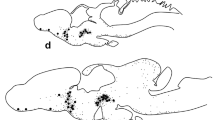Summary
Neurointermediate lobes from pituitaries of the frog, Rana berlandieri forreri (Rana pipiens, sensu lato), were maintained in organ culture in media with and without serum for up to six months. The cultured tissues were examined periodically by light microscopy and transmission electron microscopy and by bioassay of the melanophore-stimulating hormone (MSH) secreted and present in the culture media. Light-microscopic observations revealed a high degree of preservation of the pars intermedia at four weeks with isolated areas of some glands maintaining histological integrity for the entire six months. Similarly, at the ultrastructural level the cells appeared morphologically intact and to be actively synthesizing and secreting hormone. Bioassays showed the glands to be continuously secreting MSH; however, larger yields of hormone were obtained in media lacking serum. No significant ultrastructural differences between cells grown in the presence or absence of serum were detected. The difference in concentration of MSH between the two groups therefore apparently results from enzymatic degradation of the hormone by the serum. Organ culture of the vertebrate neurointermediate lobe may provide a unique method for the production of large quantities of MSH and for the study of other melanotropic and opiate peptides as they may be synthesized and secreted by the pars intermedia.
Similar content being viewed by others
References
Bradbury, A.F., Smyth, D.G., Snell, C.R.: Lipotropin: precursor to two biologically active peptides. Biochem. biophys. Res. Commun. 69, 950–956 (1976)
Castel, M.: Ultrastructure of the anuran pars intermedia following severance of hypothalamic connection. Z. Zellforsch. 131, 545–557 (1972)
Chatterjee, P.: Histological and ultrastructural studies of the rabbit pars intermedia in organ culture. I. Adult and young tissue. Cell Tiss. Res. 169, 485–500 (1976a)
Chatterjee, P.: Histological and ultrastructural studies of the rabbit pars intermedia in organ culture. II. Developing tissue. Cell Tiss. Res. 167, 387–405 (1976b)
Etkin, W.: Hypothalamic inhibition of the pars intermedia activity in the frog. Gen. comp. Endocr., Suppl. 1, 148–159 (1962)
Franzoni, M.D., Fasolo, A.: Fine structure changes induced by 6-hydroxydopamine in the pars intermedia of the newt. J. Submicr. Cytol. 7, 107–119 (1975)
Gala, R.R.: Prolactin produced by monkey (Macaca mulatta) anterior pituitaries cultured in vitro. Hormone Res. 4, 157–168 (1973)
Hadley, M.E., Bagnara, J.T.: Regulation of release and mechanism of action of MSH. Amer. Zool. 15, (Suppl. 1, 81–104 (1975)
Holley, R.W., Kiernan, J.A.: Contact inhibition of cell division in 3T3 cells. Proc. nat. Acad. Sci. (Wash.) 60, 300–304 (1968)
Hopkins, C.R.: Studies on secretory activity in the pars intermedia of Xenopus laevis. 1. Fine structural changes related to the onset of secretory activity in vivo. Tiss. Cell. 2, (1) 59–70 (1970)
Huntington, T., Hadley, M.E.: Evidence against mass action direct feedback control of melanophore stimulating hormone (MSH) release. Endocrinology 96, 472–479 (1974)
Ito, I.: Changes in skin color and fine structure of the intermediate pituitary gland of the frog, Rana nigromaculata, after extirpation of the median eminence. Neuroendocrinology 8, 180–197 (1971)
Karnovsky, M.J.: A formaldehyde-glutaraldehyde fixative of high osmolarity for use in electron microscopy. J. Cell Biol. 27 (2, Pt. 2), 137a-138a (Abstr.) (1965)
Kohmoto, K.: Mouse prolactin obtained by pituitary organ culture in a serum-free medium. Endocr. jap. 22 (5), 465–469 (1975)
Kraicer, J., Gosbee, J.L., Benscome, S.: Pars intermedia and pars distalis: two sites of ACTH production in the rat hypophysis. Neuroendocrinology 11, 156–176 (1973)
LaBella, F., Downey, G., Queen, G., Pinsky, C.: Endorphin activity in anterior, intermediate and posterior pituitary. Canad. J. Physiol. Pharm. 54, 946–948 (1976)
Li, C.H., Barnafli, L., Chrétien, M., Chung, D.: Identification and amino-acid sequence of B-LPH from sheep pituitary glands. Nature (Lond.) 208, 1093–1094 (1965)
Luft, J.H.: Improvements in epoxy resin embedding methods. J. biophys. biochem. Cytol. 9, 409–410 (1961)
Mains, R.E., Eipper, B.A., Ling, N.: Common precursor to corticotropins and endorphins. Proc. nat. Acad. Sci. (Wash.) 74, 3014–3018 (1977)
McCann, S., Porter, J.C.: Hypothalamic pituitary stimulating and inhibiting hormones. Physiol. Rev. 49, 240–284 (1969)
Meites, J., Nicoll, C.S., Talwalker, P.K.: The central nervous system and the secretion and release of prolactin. In: Advances in neuroendocrinology (A.V. Nalbandov, ed.), pp. 238. Urbana: University of Illinois Press 1963
Pasteels, J.L.: Recherches morphologiques et expérimentales sur la sécrétion de prolactine. Arch. Biol. (Liège) 74, 439–553 (1963)
Pathak, S., Fisk, A.: Histological and ultrastructural changes in the pars distalis of the rabbit pituitary in organ culture. J. Endocr. 60, 155–166 (1974)
Perryman, E.K.: An ultrastructural study of physiological control of the amphibian pars intermedia. Ph. D. Thesis, Tucson: University of Arizona (1972)
Perryman, E.K.: Fine structure of the secretory activity of the pars intermedia of Rana pipiens. Gen. comp. Endocr. 23, 94–110 (1974)
Reynolds, E.S.: The use of lead citrate at high pH as an electron-opaque stain in electron microscopy. J. Cell Biol. 17, 208–212 (1963)
Saland, L.C.: Ultrastructure of the frog pars intermedia in relation to hypothalamic control of hormone release. Neuroendocrinology 3, 72–88 (1968)
Scott, A.P., Ratcliffe, J.G., Rees, L.H., Landon, J., Bennett, H.P.J., Lowry, P.J., McMartin, C.: Pituitary peptide. Nature (Lond.) New Biol. 244, 65–67 (1973)
Shizume, K., Lerner, A.B., Fitzpatrick, T.B.: In vitro bioassay for the melanocyte stimulating hormone. Endocrinology 54, 533–560 (1954)
Tixier-Vidal, A., Gourdji, D., Tougard, C.: A cell culture approach to the study of anterior pituitary cells. Int. Rev. Cytol. 41, 173–239 (1975)
Wright, M.R., Lerner, A.B.: On the movement of pigment granules of frog melanocytes. Endocrinology 66, 599–609 (1960)
Author information
Authors and Affiliations
Rights and permissions
About this article
Cite this article
Semoff, S., Fuller, B.B. & Hadley, M.E. Secretion of melanophore-stimulating hormone (MSH) in long-term cultures of pituitary neurointermediate lobes. Cell Tissue Res. 194, 55–69 (1978). https://doi.org/10.1007/BF00209233
Accepted:
Issue Date:
DOI: https://doi.org/10.1007/BF00209233




